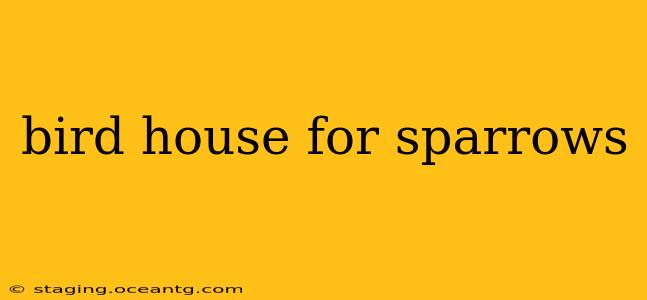Sparrows, those charming little birds flitting around our gardens and parks, often struggle to find suitable nesting sites in increasingly urbanized environments. Providing a birdhouse specifically designed for sparrows can make a significant difference in their survival and breeding success. This comprehensive guide will walk you through everything you need to know about building and placing the perfect sparrow house.
What Makes a Good Sparrow House?
Sparrows prefer smaller, simpler nest boxes compared to larger birds like robins or bluebirds. Key features include:
-
Entrance Hole Size: A crucial aspect! The entrance hole should be approximately 1 inch (2.5 cm) in diameter. This size is ideal for sparrows and helps deter larger birds and predators from accessing the nest.
-
House Dimensions: Aim for a house with internal dimensions of approximately 4 inches (10 cm) square and a height of 6-8 inches (15-20 cm). This provides ample space for a sparrow family without being overly large.
-
Ventilation: Adequate ventilation is essential to prevent overheating and mold growth. Small ventilation holes can be drilled near the top of the house.
-
Drainage: To keep the interior dry and prevent rot, ensure the house has a slightly sloping floor to facilitate water drainage.
-
Material: Use untreated, natural wood like cedar or redwood, known for their durability and resistance to rot. Avoid using treated lumber due to the potential toxicity.
What Size Birdhouse Do Sparrows Need? (Addressing a common PAA)
As mentioned above, sparrows need a smaller birdhouse than many other species. The key is the entrance hole size—1 inch—and the overall internal dimensions which should be relatively compact, around 4x4x6-8 inches. A larger house might attract unwanted guests or simply not be utilized by sparrows.
Where Should I Place a Sparrow House? (Addressing a common PAA)
Placement is crucial for attracting sparrows and ensuring the safety of their young. Consider these factors:
-
Height: Place the house 4-6 feet (1.2-1.8 meters) above the ground. This provides protection from ground predators like cats.
-
Shelter: Position the house near shrubs or trees for added protection from harsh weather and potential predators.
-
Open Space: Sparrows prefer open areas near feeding sources, so placing the house near a bird feeder or a source of natural food (like berry bushes) can increase its attractiveness.
-
Facing: Point the entrance away from prevailing winds and direct sunlight.
What Materials Can I Use to Build a Sparrow House? (Addressing a common PAA)
Untreated cedar or redwood is the preferred material due to its natural resistance to rot and its longevity. Avoid using pressure-treated wood as the chemicals can be harmful to birds. You can also use recycled wood, provided it's clean, dry, and free from any harmful chemicals. Ensure all materials are smooth to prevent injury to the birds.
How Often Should I Clean a Sparrow House? (Addressing a common PAA)
Ideally, you should clean the sparrow house after the breeding season is over (typically late summer/early autumn). Remove old nesting material gently and thoroughly clean the interior with a mild solution of water and white vinegar. Allow it to dry completely before storing it for the winter or leaving it in place for the next season.
Can I Use a Pre-Made Sparrow House? (Addressing a common PAA)
Yes, absolutely! Many retailers offer pre-made birdhouses specifically designed for sparrows. Check the dimensions and entrance hole size to ensure they meet the specifications mentioned above. This can be a great option if you prefer not to build a house yourself.
Attracting Sparrows to Your Birdhouse: Tips and Tricks
Beyond providing a suitable house, you can enhance your chances of attracting sparrows by:
- Providing a food source: Offer seeds, particularly millet and sunflower seeds, in a nearby feeder.
- Creating a water source: A birdbath or shallow dish of water will be highly appreciated, especially during hot weather.
- Maintaining a safe environment: Keep cats and other predators away from the area.
- Patience: It may take some time for sparrows to discover and occupy your new birdhouse.
By following these guidelines, you can build or acquire a welcoming and safe home for sparrows in your yard, contributing to their conservation and enjoying the delight of observing these charming birds up close. Remember, providing a birdhouse is not just about attracting birds; it's about actively participating in their well-being and enjoying the wonders of nature firsthand.
